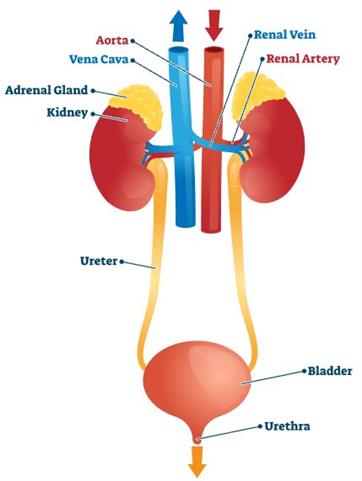PDF chapter test TRY NOW
The excretory system

The human excretory system
Ureters:
These are thin muscular tubes that emerge from the hilum. Urine reaches the ureter from the renal pelvis and is brought along by the ureter's walls' peristaltic motions. Urine is transported from the kidney to the urinary bladder through the ureters.
Urinary bladder:
It is a sac-like organ found in the pelvic cavity of the abdomen. It stores urine temporarily.
Urethra:
It is a membranous tube that transports the urine to the outside. The urethral sphincters keep the urethra closed and only open when micturition (urination).
Renal artery:
A blood vessel brings the blood containing oxygen and urea from the aorta to the kidneys.
Renal vein:
The blood vessel brings the filtered blood from the kidneys to the inferior vena cava.
Functions of kidney
- It is an organ that maintains the body's fluid and electrolyte balance
- It regulates the acid-base balance of the blood.
- Maintains the osmotic pressure in blood and tissues.
- It helps retain vital plasma constituents such as glucose and amino acids.
Structure of nephron
There are more than \(1\)million nephrons in each kidney. The uriniferous tubules, also known as nephrons, are structural and functional units of the kidneys.
Each nephron consists of a renal corpuscle or Malpighian corpuscle and renal tubule. The renal corpuscle comprises a cup-shaped structure called Bowman's capsule, which includes a glomerulus, which is a series of capillaries.
Blood enters the glomerular capillaries through afferent arterioles and leaves through efferent arterioles. Afferent arterioles bring blood into the glomerular capillaries, and efferent arterioles take it out.
The Bowman's capsule continues as the renal tubule, divided into three sections:
- Proximal convoluted tubule
- \(U\)-shaped hairpin loop (the loop of Henle)
- Distal convoluted tubule
The distal convoluted tubule opens into the collecting tubule. The nitrogenous wastes are drained into the renal pelvis and then into the ureters, deposited in the urinary bladder. The urethra later expels this urine out.

The internal structure of a nephron
Reference:
https://upload.wikimedia.org/wikipedia/commons/9/9c/Figure_41_03_03.png
